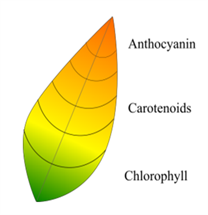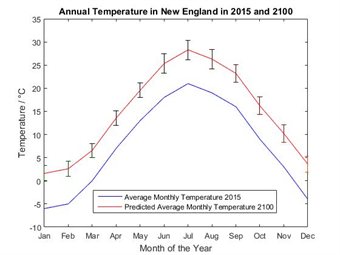The effect of climate change on autumn leaf colour
T. Ashford, C. Day, R. Fernandes, L. Giles, K. Linton, E. Skinner

Figure 1 - The pigments involved in leaf colour
There are three groups of pigments responsible for autumnal leaf colour change (figure 1). Chlorophyll is responsible for the green colour of leaves for most of the year. It is used for photosynthesis and decreases in concentration during the autumn.
Carotenoids are yellow photoprotective pigments, present for most of the year, but are masked by chlorophyll. Anthocyanins are red protective pigments and they are synthesised during the autumn period.
The effect of changing both temperature and CO2 on the three pigments was investigated individually. We decided to focus on New England, USA, renowned for its autumn foliage.
Statistical sign tests predicted the certainty of changes in pigment concentration due to these environmental conditions. To estimate the effect of climate change on autumn leaf colour, predictions of temperature and CO2 in the year 2100 were used.
It is estimated that New England temperatures will increase between 3.3-6.1ºC from their current values. The temperature currently associated with autumnal onset is 16ºC; by 2100 this temperature will be delayed by 4 weeks (figure 2). It was also found that increased temperatures will accelerate autumnal colour change once autumn has begun.
It is estimated that CO2 levels will rise from 400ppm to 650-800ppm by 2100, further delaying chlorophyll breakdown. Overall, autumn onset will be delayed by 4 weeks or more with a faster rate of leaf colour change.
Delayed leaf colour change will result in the growing season extending later into the year. This will increase carbon sequestration, consequently decreasing atmospheric CO2. In New England, this will result in shorter tourism season severely impacting the local economy.

Figure 2 - Annual temperature variations in New England in 2015 and 2100
Additionally, many animal species rely on leaf colour change for migration as well as a food source. Therefore delayed autumn colour change may also have significant impacts on local ecosystems.